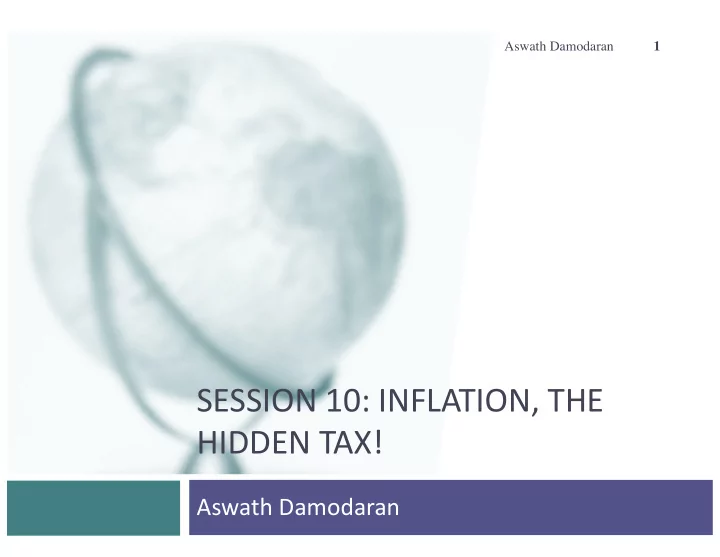

Aswath Damodaran 1 SESSION 10: INFLATION, THE HIDDEN TAX! Aswath Damodaran
What is inflation? 2 ¨ Put simply, inflation refers to a general rise in prices and deflation is the general fall in price level. ¤ Thus, you can have the prices of some products and services rise and no overall inflation, if that price rise is offset by falling prices on other products and services. ¤ These relative price changes, even though they do not show up as inflation, can affect individuals who consume more or less of the goods & services that are affected by relative price changes ¨ In investing and finance, we care about inflation because it affects how much we value a cash flow today as opposed to an equal cash flow in the future. Aswath Damodaran 2
How is it measured? 3 ¨ To measure inflation, you need to first decide whether to invest it from the perspective of consumers or producers, and within each perspective, pick a basket of goods and services that you will use to estimate price level changes. ¨ In most parts of the world, inflation is estimated by a government or government agency, with each one often using different approaches. ¨ In the US, for instance, the government measures inflation in multiple ways: ¤ Consumer Price Index (CPI) , measuring change over time in prices paid for a market basket of consumer goods/services. ¤ Producer Price Index (PPI) , measuring change in the prices received by producers of goods and services. ¤ GDP deflator , calculated from nominal and real GDP growth numbers, focused on price changes in all goods and services. Aswath Damodaran 3
Inflation Measurement: Errors and Biases? 4 ¨ Basket of goods/services: All inflation measures are based upon measuring and remeasuring prices on a basket of goods and services that reflects the usage of these. To the extent that this basket is mis-specified, or mis-measured, the measured inflation can be different from actual inflation. ¨ Sources for prices: When computing inflation, the question of how and when prices are observed for goods and services can have an effect on measured inflation. ¨ Other biases: Most inflation rates are measured by governments or government agencies. To the extent that governments have an interest in how much inflation is reported (with most preferring lower rates), there can be pressure on those measuring inflation to skew numbers. Aswath Damodaran 4
Inflation Rates: US 5 Aswath Damodaran 5
What causes inflation? 6 ¨ Government Spending: In periods where governments have to spend money they do not have in large quantities, to fend off a crisis or fund a war, inflation can surge. ¨ Real Economic Growth: In periods of high economic growth, there will be more inflationary pressures as consumers have more spendable income, and production may not be able to keep up. ¨ Monetary Policy: Ultimately, inflation is a monetary phenomenon, and governments that print money more liberally are likely to see more inflation, at least in the long term. Aswath Damodaran 6
Real versus Nominal 7 ¨ We live in a nominal world. Our wages, taxes and returns are all computed in nominal terms. ¨ That said, the value of these wages, the amount of taxes we pay and the returns we earn can be affected by inflation during the period. ¨ Thus, the same wages, taxes and returns are worth a lot less over time, if there is high inflation as opposed to low inflation or deflation. Aswath Damodaran 7
Converting Nominal to Real Returns 8 ¨ The nominal return on an investment incorporates inflation. In its simpler form: ¤ Nominal Return = Real Return + Inflation ¤ To the extent that there is a compounding effect, a more precise measure is (1+ Nominal Return) = (1 + Real Return) (1 + Inflation Rate) ¨ If you estimate the nominal return on an investment, converting it into a real return is straightforward: ¤ Real Return = ("# $%&'()* +,-./() - 1 ("#1(2*)-'%( +)-,) Aswath Damodaran 8
US Equities: Nominal and Real Returns 9 Aswath Damodaran 9
US Equities: Quantifying the inflation effect 10 Value of $100 invested in 1928 in US Stocks: Nominal and Real Terms $600,000.00 $502,417.21 $500,000.00 $400,000.00 $300,000.00 $200,000.00 $100,000.00 $33,953.22 $- 1928 1930 1932 1934 1936 1938 1940 1942 1944 1946 1948 1950 1952 1954 1956 1958 1960 1962 1964 1966 1968 1970 1972 1974 1976 1978 1980 1982 1984 1986 1988 1990 1992 1994 1996 1998 2000 2002 2004 2006 2008 2010 2012 2014 2016 2018 Compounded value of $100 (nominal) Compounded value of $100 (real) Aswath Damodaran 10
Nominal to Real Cash Flows 11 ¨ The process of converting nominal to real is the same for growth rates and cash flows, as it is for returns. ¨ With growth rates, you can use either the short cut or the more precise compounding value: ¤ Real Growth Rate = Nominal Growth Rate – Inflation Rate ¤ Real Growth Rate = ("# $%&'()* +,%-./ 0).1) - 1 ("#3(4*).'%( 0).1) ¨ With cash flows, to get from nominal cash flows in a future year (t) to real cash flows in that year, you do the following: ¤ Real Cash Flow t = $%&'()* 5)6/ 7*%- ! ("#3(4*).'%( 0).1) ! Aswath Damodaran 11
Recommend
More recommend